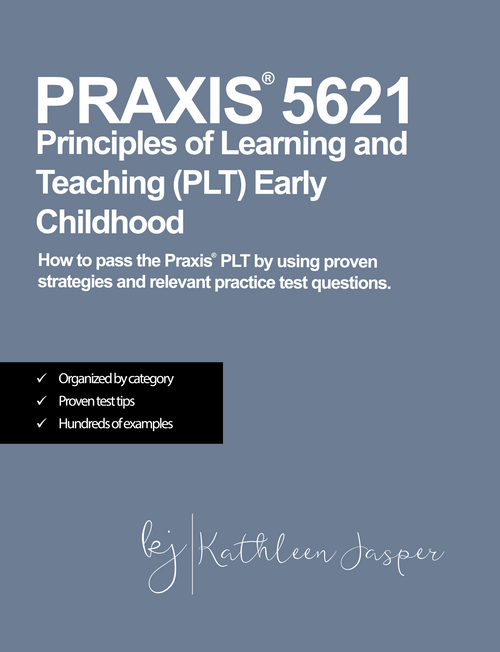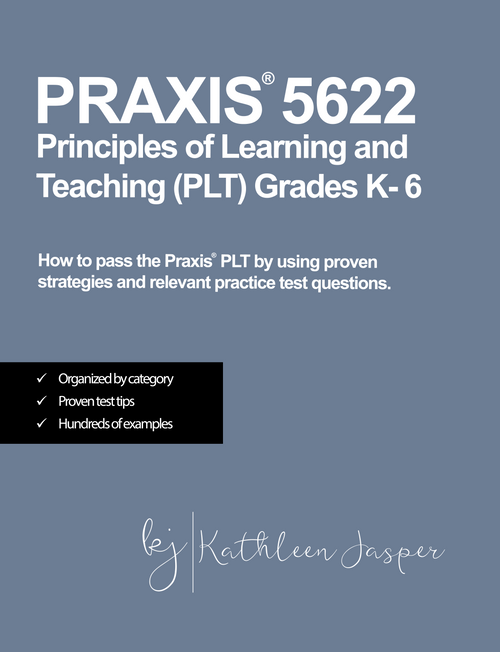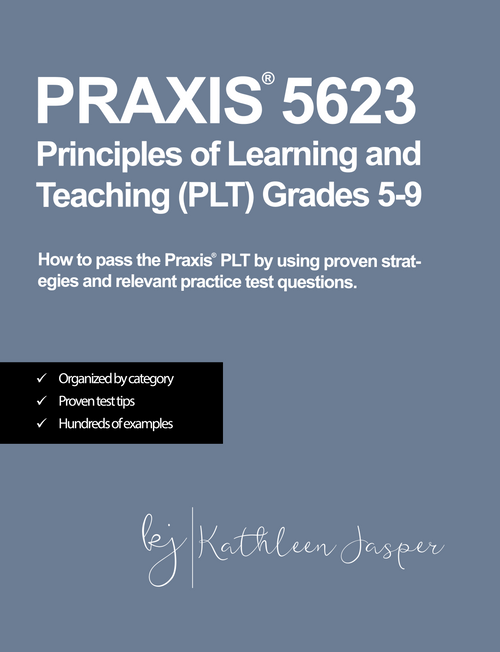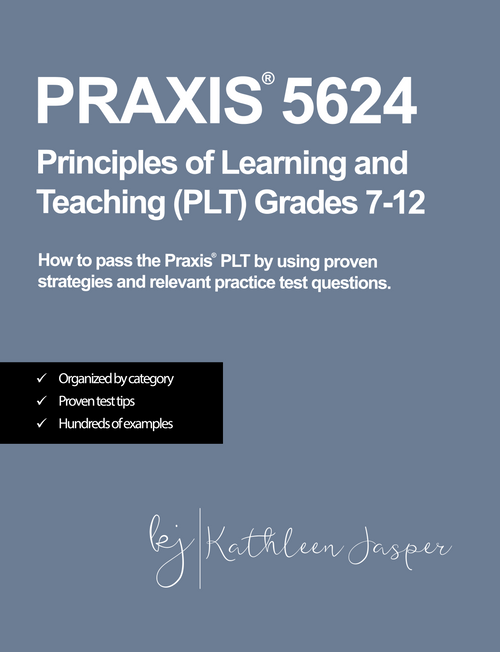What is the Praxis Principles of Learning and Teaching (PLT)?
The purpose of the Praxis PLT is to assess a prospective teacher's understanding of educational practices and theories, professional issues, and related topics that are necessary for beginning professional practice.
The Praxis PLT comes in 5 different exams:
PLT 5622 - Elementary Education Grade K-6
PLT 5623 - Middle School Grade 5-9
PLT 5624 - High School Grade 7-12
The test you are required to take depends on the grade level and state in which you are seeking certification.
Our proven Praxis PLT study guides
Which PLT do I need to take?
Preschool teachers take the PLT 5621, elementary teachers take the PLT 5622, middle school teachers take the PLT 5623, and high school teachers take the PLT 5624.
Some states have moved to require the Praxis PLT 5625, which assesses all grade levels–PreK-12.
States that currently use the Praxis PLT 5621 - 5624:
- Alabama
- American Samoa
- Arkansas
- Department of Defense Education Activity (DoDEA)
- District of Columbia
- Guam
- Hawaii
- Indiana
- Kansas
- Kentucky
- Louisiana
- Maine
- Maryland
- Mississippi
- Nevada
- New Mexico
- North Dakota
- Northern Mariana Islands (CNMI)
- South Carolina
- South Dakota
- Tennessee
- Utah
- Virgin Islands
- West Virginia
States that use the Praxis PLT 5625 - Grades PreK-12:
- Hawaii
- Indiana
- Kansas
- South Carolina
- South Dakota
It is important you check your state’s specific requirements by accessing your state Department of Education’s website. You can also check here.
Which Praxis PLT test do I need to take to teach Elementary Education?
Many states use the Praxis PLT 5622 exam to certify their elementary education teachers. However, it's important to note requirements can vary depending on your state's licensure regulations.
Some states might have different tests or additional requirements for prospective teachers.
That’s why it's crucial to check with your state's Department of Education or the ETS website to confirm the exact requirements for becoming an elementary education teacher in your state.
How hard is the Praxis PLT to pass?
The Praxis PLT exam is scenario-based, meaning the selected-response questions are usually structured in a way that requires the test taker to analyze a classroom situation and choose the best answer. There are several reasons why some candidates might struggle:
- Lack of classroom experience: Most people taking the exam have little to no experience as teachers. Therefore, some of the questions may be difficult to navigate.
- Breadth and depth of content: The Praxis PLT tests cover a wide range of topics, including students as learners, instructional processes, assessment, professional development, leadership, and community. Each of these areas is complex, and prospective teachers need to have a strong grasp of multiple topics to do well on the test.
- Application of theory: It's not enough to simply memorize educational theories and principles. The Praxis PLT tests often require test takers to apply this knowledge to real-world scenarios, which can be challenging.
- Test-taking skills: The Praxis PLT tests include a variety of question types, including multiple choice and constructed-response. Candidates need strong test-taking skills to navigate these different formats.
- Time management: Like many standardized tests, the Praxis PLT tests are timed. Candidates need to answer all questions in a set amount of time, which can add pressure and difficulty.
- Constructed-Response: The Praxis PLT 5621 - 5624 have a constructed-response section that many people find challenging. This part of the test requires test takers to examine classroom scenarios and respond in writing. .
Proper preparation is key to success on these exams. Some candidates may find the tests difficult because they are not adequately prepared.
It's crucial to utilize study guides, practice tests, and other resources to prepare for the Praxis PLT tests.
What does the Praxis PLT Consist of?
The test has a range of questions on education theory, best practices in classroom management, content-area reading instruction, differentiation for students who struggle, professional development, assessment, and major laws in education.
All of the Praxis PLT exams, regardless of grade level, have the same content categories:
- Students as Learners
- Instructional Process
- Assessment
- Professional Development, Leadership, and Community
- Analysis of Instructional Scenarios
- Students as Learners
- Instructional Process
- Assessment
- Professional Development, Leadership, and Community
The first four categories are selected of Instructional Practice–is the constructed-response section.
Notice the constructed-response portion pulls from the four content categories of the exam. Therefore, be prepared for constructed-response questions that cover all the categories of the exam.
The selected-response section is worth 75% of the overall score, while the constructed-response questions are worth 25% of the overall score. Therefore, you will want to be strong in both categories.
What is the difference between the Praxis PLT 5625 and the other Praxis PLT exams (5621, 5622, 5623, and 5624)?
The biggest difference between the Praxis PLT 5625 and all the other PLT exams is that the PLT 5625 does not have a constructed-response section.
The PLT 5625 exam is all selected-response. Also, there are 100 selected response questions; the others have 70 selected-response questions.
The PLT 5625 (all grade levels) contains the same four content categories as the other PLT exams:
- Students as Learners
- Instructional Process
- Assessment
- Professional Development, Leadership, and Community
Praxis PLT 5621 - Early Childhood
The Praxis PLT 5621 has approximately 70 selected-response and four constructed-response questions. You will have two hours to complete the exam. Most states require at least a score of 157 to pass this exam.
The exam covers the same content categories and selected-response questions as all the Praxis PLTs. However, the questions and constructed-response will focus on early childhood classroom scenarios.
You can read our full overview and breakdown of the Praxis PLT 5621 and our best tips to pass the exam here.
Praxis PLT 5622 - Elementary Grades K-6
The Praxis PLT 5622 has approximately 70 selected-response and four constructed-response questions. You will have two hours to complete the exam. Most states require at least a score of 160 to pass this exam.
The exam covers the same content categories and selected-response questions as all the Praxis PLTs. However, the questions and constructed-response will focus on elementary education classroom scenarios.
You can read our full overview and breakdown of the Praxis PLT 5622 and our best tips to pass the exam here.
Praxis PLT 5623 - Middle School Grades 5-9
The Praxis PLT 5623 has approximately 70 selected-response and four constructed-response questions. You will have two hours to complete the exam. Most states require at least a score of 160 to pass this exam.
The exam covers the same content categories and selected-response questions as all the Praxis PLTs. However, the questions and constructed-response will focus on middle school classroom scenarios.
You can read our full overview and breakdown of the Praxis PLT 5623 and our best tips to pass the exam here.
Praxis PLT 5624 - High School Grades 7-12
The Praxis PLT 5624 has approximately 70 selected-response and four constructed-response questions. You will have two hours to complete the exam. Most states require at least a score of 157 to pass this exam.
The exam covers the same content categories and selected-response questions as all the Praxis PLTs. However, the questions and constructed-response will focus on high school classroom scenarios.
You can read our full overview and breakdown of the Praxis PLT 5624 and our best tips to pass the exam here.
Praxis PLT 5625 - All Grade Levels
The Praxis PLT 5625 has approximately 100 selected-response questions. You will have two hours to complete the exam. The states that use the PLT 5625 require a score of 157 to pass this exam.
There is no constructed-response section for the PLT 5625. It only contains selected-response questions.
You can read our full overview and breakdown of the Praxis PLT 5625 and our best tips to pass the exam here.
What are the passing scores for the Praxis PLT?
Each state sets the passing score for the Praxis PLT. These passing scores vary from state to state and are based on grade levels.
For example, the passing score for the PLT 5621 in many states is a 157, while the passing score for the PLT 5622 in many states is a 160.
Therefore, it is important that you locate your state’s specific requirements for this exam. The following is a range of scores for each subtest.
Passing score for the Praxis PLT 5621 Early Childhood
Most states require a score of 157 to pass this exam. However, Utah and Kansas require a 160. Northern Mariana Islands (CNMI) requires a score of 163.
Passing Score for the Praxis PLT 5622 Elementary
Most states require a score of 160 to pass this exam. However, Kentucky only requires 155. Northern Mariana Islands (CNMI) requires a score of 163.
Passing Score for the Praxis PLT 5623 Middle School
Most states require a score of 160 to pass this exam. However, Kentucky only requires 155. Northern Mariana Islands (CNMI) requires a score of 163.
Passing Score for the Praxis PLT 5624 High School
Passing Scores by state range from 155-163. Most states that use this exam require a 157.
Passing Score for the Praxis PLT 5625
All of the states that use the Praxis PLT 5625 require a score of 157.
It is important to note that the Praxis PLT is scored using a scale score. This is much different than a raw score.
Scale scores are determined by taking your raw score (how many you got correct) and configuring it into a scale score based on question complexity, form of the test, and other measures. To learn more about this, check out this blog: How to Calculate Your Praxis Score.
How many questions are on the Praxis PLT?
The Praxis PLT 5621, 5622, 5623, and 5624 all have approximately 70 selected-response questions and 4 construction response questions. They are broken up by content category.
- Students as Learners - approximately 21 questions
- Instructional Process- approximately 21 questions
- Assessment- approximately 14 questions
- Professional Development, Leadership, and Community - approximately 14 questions
- Analysis of Instructional Scenarios (constructed-response) - 4 questions
For the Praxis PLT 5625 has approximately 100 questions. They are broken up by content category.
- Students as Learners - approximately 31 questions
- Instructional Process- approximately 30 questions
- Assessment- approximately 20 questions
- Professional Development, Leadership, and Community - approximately 19 questions
Why did my test have more questions than it was supposed to?
Please understand that you may have several additional questions on your test. ETS, the company that makes the exam, will often field test new items on the exams. You will never know which test items count toward your score and which items are being field tested. You can learn more about this HERE.
Field testing items is common practice in the testing industry. Therefore, if you see a couple more questions on your exam, don’t panic. Just answer all the questions on your test.
The best ways to pass the Praxis PLT?
Everyone is different in terms of how they want to prepare for the exam. People have different strengths and weaknesses, and it’s important you choose the right program for you. The following are a few resources you can consider when preparing for this test.
The ETS Study Companion
The first and most important thing you can do to pass your Praxis PLT exam is to review the test structure and content on the text by examining the test specifications in the Praxis PLT Study Companions. This document is developed by ETS and shows you everything you are responsible for on the exam. It even has practice test questions similar to what you will see on test day.
Click the links below to access your test’s study companion:
Praxis PLT 5621 Study Companion
Praxis PLT 5622 Study Companion
Praxis PLT 5623 Study Companion
Praxis PLT 5624 Study Companion
Praxis PLT 5625 Study Companion
Study Guides
Beyond that, most people prefer to use a study guide with practice tests to prepare for the exam. Our Praxis PLT study guides are fully aligned with the test specifications and blueprint outlined in the ETS Study Companion. They also have hundreds of practice test questions for each subtest and content category, so you are fully prepared for the exam.
Online Courses
For those who need additional support, online courses that come with tutorial videos and practice are helpful. We have comprehensive, self-paced online courses with hours of videos that will help you pass this test.
How many questions do you need to get right to pass?
It is difficult to predict exactly how many questions you must get correct to pass the Praxis PLT because a scale score is used rather than a raw score. This means that your raw score—the number of questions you get correct—is put into a formula to calculate a scale score.
To keep things simple, we recommend scoring at least a 75% on the practice tests before you go in to take the exam. Getting 75% of the questions correct when you practice indicates you are ready to take the actual test.
Remember, each section of the exam is scored separately.
What if I failed the Praxis PLT?
If you were not successful on the Praxis PLT the first time around, you are not alone. Recent research on teacher certification exams shows that fewer than 50% of test takers pass their exams the first time around.
If you took the exam and were not successful, it is important to analyze your score report effectively so that you can concentrate on the areas in which you were low. I have a comprehensive video on how to read the PLT score report on my YouTube channel.
Free resources for the Praxis PLT
There are many free resources you can use to pass the exam. Our PLT YouTube Channel Playlist has tons of videos for this exam and its individual subtests. You might also want to check out our free Praxis PLT webinar. It comes with a free study guide, test strategy tips, and more. Just fill out this form and you will gain access to all of that.





